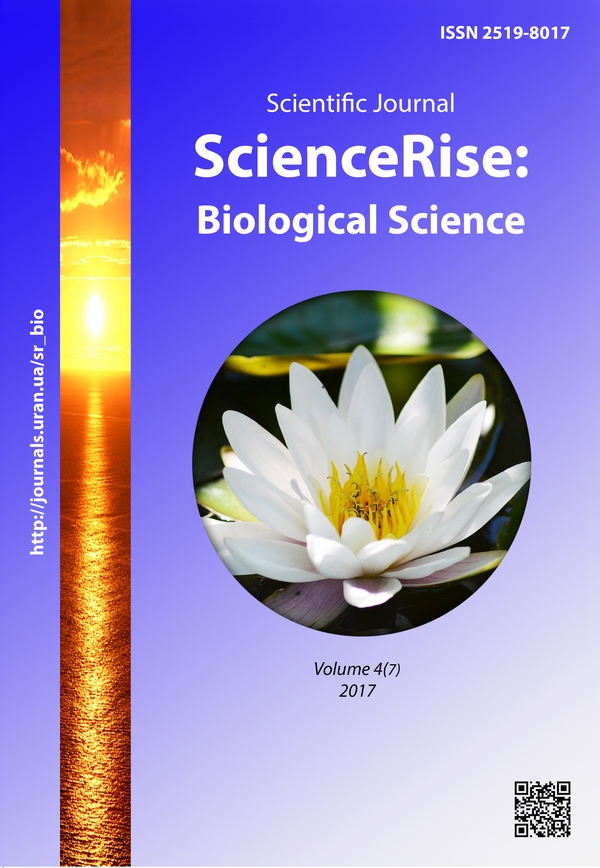The therapeutic efficacy of 1-[4-(1,1,3,3-tetramethyl butyl) phenoxy]-3-(n-benzyl hexametylenimino)-2-propanol chloride in vivo
DOI:
https://doi.org/10.15587/2519-8025.2017.109317Keywords:
antifungal activity, experimental mycosis, derivative of arilalifatic aminopropanols, C. albicans, therapeutic efficacyAbstract
The aim of the research was to determine the therapeutic efficacy of the derivative of arilalifatic aminopropanols 1-[4-(1,1,3,3-tetramethyl butyl)phenoxi]-3-(N-benzyl hexamethylenimino)-2-propanol chloride (compound КВМ-194) in experiments in vivo on the model of the generalized infection, conditioned by Candida albicans.
Methods. The experimental generalized infection was recreated on white nonlinear mice, using C. albicans 1486 strain. The infecting dose was 107 of fungal elements/animal. The efficacy of КВМ-194 was determined in the prophylactic, treating-prophylactic and treating regimes at intraoperational administration of the compound in doses 0,01 LD50 та 0,001 LD50.
Results. It was established, that in the prophylactic regime of use at the intraoperational administration, the compound KVM-194 in a dose 0,001 LD50 favors survival of 50 % of animals, in a dose 0,01 LD50 - 100 % of infected animals (at 100 % death in the control). At the administration in the treating-prophylactic regime in a dose 0,01 LD50 this compound prevent death of 50 % of infected animals. The derivative of arilalifatic aminopropanols revealed the most expressed efficacy at the generalized candidiasis in the treating regime of use: at the administration of КВМ-194 in doses 0,001 LD50 and 0,01 LD50 death of experimental animals is absent (at 100 % of death in the control).
Conclusions. The obtained data testify to the efficacy of the derivative of arilalifatic aminopropanols in low doses at generalized mycosis, conditioned by C. albicans, and prospects of the elaboration of an effective antifungal preparation on its base.
References
- Vandeputte, P., Ferrari, S., Coste, A. T. (2012). Antifungal Resistance and New Strategies to Control Fungal Infections. International Journal of Microbiology, 2012, 1–26. doi: 10.1155/2012/713687
- Thompson, G. R., Cadena, J., Patterson, T. F. (2009). Overview of Antifungal Agents. Clinics in Chest Medicine, 30 (2), 203–215. doi: 10.1016/j.ccm.2009.02.001
- Mitrofanov, V. S. Sistemnye antifungal'nye preparaty. [Systemic antifungal preparations]. Available at: http://www.rusmedserv.com/mycology/html/preparat1.html
- Odds, F. C., Brown, A. J. P., Gow, N. A. R. (2003). Antifungal agents: mechanisms of action. Trends in Microbiology, 11 (6), 272–279. doi: 10.1016/s0966-842x(03)00117-3
- Spampinato, C., Leonardi, D. (2013). CandidaInfections, Causes, Targets, and Resistance Mechanisms: Traditional and Alternative Antifungal Agents. BioMed Research International, 2013, 1–13. doi: 10.1155/2013/204237
- Fothergill, A., Birch, M., Law, D. et. al. (2016). The novel orotomide F901318 demonstrates potent in vitro antifungal activity against Lomentospora and Scedosporium species. 26th European Congress of Clinical Microbiology and Infectious Diseases, No. 4366.
- Mor, V., Rella, A., Farnoud, A. M., Singh, A., Munshi, M., Bryan, A. et. al. (2015). Identification of a New Class of Antifungals Targeting the Synthesis of Fungal Sphingolipids. mBio, 6 (3), e00647–15. doi: 10.1128/mbio.00647-15
- Dronova, M. L., Korotkii, Yu. V., Vrynchanu, N. O. et. al. (2015). Sintez, antibakterial'na ta protigribkova aktivnist' chetvertinnikh soley 1-[4-(1,1,3,3-tetrametilbutil)fenoksi]-3-díalkílamíno-2-propanolu [Synthesis, antibacterial and prothigribine activity of quaternary salts of 1-[4-(1,1,3,3-tetramethylbutyl)phenoxy]-3-diallylamino-2-propanol]. Pharmaceutical Journal, 1, 56–61.
- Dronova, M. L. (2015). Chuvstvitel'nost' bioplenok Staphylococcus aureus k deystviyu proizvodnykh arilalifaticheskikh aminospirtov [The sensitivity of Staphylococcus aureus biofilms to the action of derivatives of arylaliphatic amino alcohols]. Universum: Medicine and Pharmacology: electron, 2, Available at: http://7universum.com/ru/med/archive/item/1932
- Suvorova, Z. S., Dronova, M. L. (2015). Antimíkrobna aktivníst' 1-[4-(1,1,3,3-tetrametilbutil)fenoksi]-3-(N-benzilgeksametilenímíníy)-2-propanolu khloridu [Antimicrobial activity of 1-[4-(1,1,3,3-tetramethylbutyl)phenoxy]-3-(N-benzylhexamethyleneimine)-2-propanol chloride]. Pharmacology and toxic toxicology, 6 (46), 64–69.
- Sarkisov, D. S., Remezov, P. I. (1960). Vosproizvedeniye bolezney cheloveka v eksperimente [The reproduction of human diseases in the experiment]. Moscow: Medicine, 780.
- Lazarev, N. V. (1954). Vosproizvedenie zabolevanii u zhivotnykh [Reproduction of diseases in animals]. Moscow: Medgiz, 396.
- Pershina, G. N. (Ed.) (1971). Metody eksperimental'noy khimioterapii [Methods of experimental chemotherapy]. Moscow: Medicine, 541.
- Dronova, M. L., Vrynchanu, N. O., Korotkii, Yu. V., Suvorova, Z. S., Nedashkishivska, V. V. (2015). Farmakologicheskie i toksikologicheskie svoistva proizvodnykh 4-(1,1,3,3-tetrametil butil)fenoksi-3-amino-2-propanola i ikh chetvertichnykh soley [Pharmacological and toxicological properties of 4-(1,1,3,3-tetramethyl butyl) phenoxy-3-amino-2-propanol derivatives and their quaternary salts]. The Forth European Conference on Biology and Medical Sciences, 144–154.
- European convention for the protection of vertebrate animals used for experimental and other scientific purposes (1986). Strasbourg: Council of Europe, 53.
- Khalafyan, A. A. (2007). Statistica 6. Statistical analysis of the data. Moscow: Binom-Press, 512.
- Dronova, M. L. (2016). The therapeutic efficacy of 1-[4-(1,1,3,3-tetramethylbutyl)phenoxy]-3-(N-benzylhexametylenimino)-2-propanol chloride under in vivo models. Pharmacology and Drug Toxicology, 1 (47), 60–65.
Downloads
Published
How to Cite
Issue
Section
License
Copyright (c) 2017 Zinaida Suvorova

This work is licensed under a Creative Commons Attribution 4.0 International License.
Our journal abides by the Creative Commons CC BY copyright rights and permissions for open access journals.
Authors, who are published in this journal, agree to the following conditions:
1. The authors reserve the right to authorship of the work and pass the first publication right of this work to the journal under the terms of a Creative Commons CC BY, which allows others to freely distribute the published research with the obligatory reference to the authors of the original work and the first publication of the work in this journal.
2. The authors have the right to conclude separate supplement agreements that relate to non-exclusive work distribution in the form in which it has been published by the journal (for example, to upload the work to the online storage of the journal or publish it as part of a monograph), provided that the reference to the first publication of the work in this journal is included.









